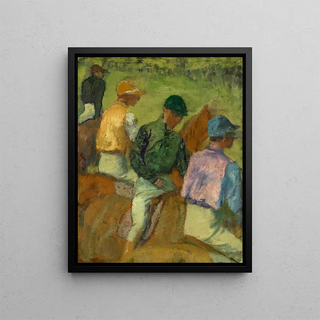Art print | Four Jockeys - Edgar Degas


View from behind

Frame (optional)
In the fascinating world of art, some works transcend eras and capture the essence of a moment with such intensity that they become essential references. "Quatre jockeys" by Edgar Degas is undoubtedly one of these iconic creations. Painted in the heart of the 19th century, this piece immerses us in the vibrant universe of horse racing, a subject dear to the artist. The scene, lively and dynamic, evokes not only the passion for equestrian sport but also the elegance of the characters involved. The art print Quatre jockeys - Edgar Degas thus allows for rediscovering this masterpiece, while offering a window into the very soul of the artist.
Style and uniqueness of the work
Degas's style stands out for its unique approach to movement and light. In "Quatre jockeys," the artist manages to capture the palpable tension that reigns before a race begins. The jockeys, frozen in postures that are both natural and theatrical, seem ready to launch themselves, embodying a liveliness that transcends the canvas. Degas uses rich colors and subtle contrasts to create an atmosphere that is both dynamic and intimate. The composition, although centered on the jockeys, is also enriched by background elements that evoke the setting of the races, thus reinforcing the idea of a fleeting moment captured for eternity. This blend of realism and impressionism, characteristic of his work, demonstrates impressive technical mastery while revealing a deep artistic sensitivity.
The artist and his influence
Edgar Degas, an emblematic figure of the Impressionist movement, knew how to mark his era with his innovative perspective on modern life. Born in 1834 in Paris, he was initially influenced by the great masters of the past before developing a style that is uniquely his own. His interest in movement and the representation of the human body, notably through dance and horse racing, allowed Degas to stand out among his contemporaries. His work is not limited to painting alone; he also explored sculpture, pastel, and engraving, enriching the artistic landscape with his

Matte finish

View from behind

Frame (optional)
In the fascinating world of art, some works transcend eras and capture the essence of a moment with such intensity that they become essential references. "Quatre jockeys" by Edgar Degas is undoubtedly one of these iconic creations. Painted in the heart of the 19th century, this piece immerses us in the vibrant universe of horse racing, a subject dear to the artist. The scene, lively and dynamic, evokes not only the passion for equestrian sport but also the elegance of the characters involved. The art print Quatre jockeys - Edgar Degas thus allows for rediscovering this masterpiece, while offering a window into the very soul of the artist.
Style and uniqueness of the work
Degas's style stands out for its unique approach to movement and light. In "Quatre jockeys," the artist manages to capture the palpable tension that reigns before a race begins. The jockeys, frozen in postures that are both natural and theatrical, seem ready to launch themselves, embodying a liveliness that transcends the canvas. Degas uses rich colors and subtle contrasts to create an atmosphere that is both dynamic and intimate. The composition, although centered on the jockeys, is also enriched by background elements that evoke the setting of the races, thus reinforcing the idea of a fleeting moment captured for eternity. This blend of realism and impressionism, characteristic of his work, demonstrates impressive technical mastery while revealing a deep artistic sensitivity.
The artist and his influence
Edgar Degas, an emblematic figure of the Impressionist movement, knew how to mark his era with his innovative perspective on modern life. Born in 1834 in Paris, he was initially influenced by the great masters of the past before developing a style that is uniquely his own. His interest in movement and the representation of the human body, notably through dance and horse racing, allowed Degas to stand out among his contemporaries. His work is not limited to painting alone; he also explored sculpture, pastel, and engraving, enriching the artistic landscape with his






